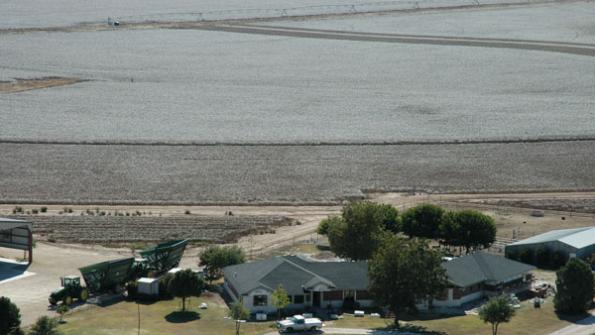
Urban land values fall as rural values rise
In spite of the uncertain economy and regardless of wavering consumer confidence, while urban land values have declined by as much as 70 percent since 2006, USDA figures indicate land values in rural America have jumped by 20 percent or more, and perhaps more surprising, western states like Arizona and California are reporting more land is being utilized for farming.

It has been a tough year for farming. Drought, floods, and escalating production costs are just a few of the ongoing concerns of U.S. agriculture producers, and it hasn’t been much easier in urban areas either as higher energy costs, tighter financial markets, falling real estate values and growing food costs add to the problems of an unstable economy.
Yet in spite of the uncertain economy and regardless of wavering consumer confidence, while urban land values have declined by as much as 70 percent since 2006, USDA figures indicate land values in rural America have jumped by 20 percent or more, and perhaps more surprising, western states like Arizona and California are reporting more land is being utilized for farming.
It is statistics like these that have at least one agriculture economist wondering if there could be a renaissance of farming in America's future.
“Rural land values are essentially being driven by the high prices of commodity crops like corn, rice and cotton. These historically high markets have added greatly to the stability of rural land values. It would be fair to say there is a farming renaissance underway as available crop acreage is in high demand,” says Dr. Charles Gilliland, research economist at the Texas A&M University’s Real Estate Center in College Station.
Gilliland says it is a positive sign when rural land values rise at a time when the overall economy has been suffering.
“We are seeing buyers grab CRP lands that are coming out of the [conservation] program. For one, corn is being driven by ethanol and other alternative fuel development and the demand for soybean crops are being driven by healthy Chinese exports, so there should be little surprise that productive crop land is in high demand,” Gilliland adds.
He says institutional investors and wealthy real estate speculators are contributing to strong rural land values as they buy up crop acres as soon as they are available on the open market and who then lease the acreage to farmers for crop development.
Richard Brock, president of Brock Associates, a farm market advisory firm, and publisher of The Brock Report, agrees.
“It is no secret most rural real estate values have gone through the roof over the last two years. In Arizona and Southern California, for example, values are at a premium,” Brock says, indicating it is a great time to buy or sell rural real estate. “We are going to see a shift in acres to more corn because of the strong market and high demand.”
But he warns that a leveling of commodity prices will result in a leveling of rural land values as well, and says a softening of market prices “is inevitable.”
Brock says rural land values in Texas have not increased as much as in western states but says the market remains “healthy.” He says the drought in Texas has affected land values but it has not weakened them, and says land values in the state remain steady.
Adding to rural land values in Texas is a return of agriculture to acres that had once been dedicated to urban expansion. The housing crash and tighter investment markets have slowed urban expansion and prompted rural development, and those capable of building in suburbia are trending toward more rural areas where they can generate land revenues through small farms and ranches or by establishing specialty crops. In a few instances, rural operations of less than 100 acres have included horse stabling and pasturing operations and hunting leases.
In spite of floods, wildfires and droughts, USDA statistics indicate net farm income nationwide is forecast to rise by 31-percent this year to just over $103 billion, and some economists say this could contribute to a growing interest in both commodity and specialty crops.
Statistical trends may provide a glimpse into farming’s future, but statistics can support most any argument Gilliland says. While rural land values remain high and more land is being dedicated to agriculture, it is also true that for the first seven years of the last decade farmland values fell by nearly 2 million acres. In contrast, since 2008, farmland acres have leveled off and remain steady at about 920 million acres.
Brock warns that the prime time for grabbing up rural land for crop production is slowly passing as markets soften. But Gilliland says while rural land values may soon trend downward slightly, rural real estate remains a good investment for those able to add to their total acreage.
About the Author(s)
You May Also Like





